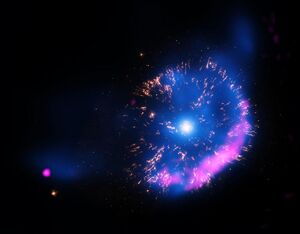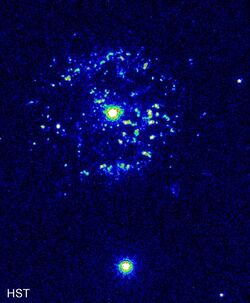Nova remnant
Topic: Astronomy
 From HandWiki - Reading time: 4 min
From HandWiki - Reading time: 4 min

A nova remnant is made up of the material either left behind by a sudden explosive fusion eruption by classical novae, or from multiple ejections by recurrent novae. Over their short lifetimes, nova shells show expansion velocities of around 1000 km/s,[1] whose faint nebulosities are usually illuminated by their progenitor stars via light echos as observed with the spherical shell[1] of Nova Persei 1901[2] or the energies remaining in the expanding bubbles like T Pyxidis.[3]
Form
Most novae require a close binary system, with a white dwarf and a main sequence, sub-giant, or red giant star, or the merging of two red dwarfs, so probably all nova remnants must be associated with binaries.[4] This theoretically means these nebula shapes might be affected by their central progenitor stars and the amount of matter ejected by novae.[1] The shapes of these nova nebulae are of much interest to modern astrophysicists.[1][4]
Nova remnants when compared to supernova remnants or planetary nebulae generate much less both in energy and mass. They can be observed for perhaps a few centuries.[1] Notably, more nova remnants have been found with the new novae, due to improved imaging technology like CCD and at other wavelengths. Examples of novae displaying nebula shells or remnants include the following:[1]
See also
References
- ↑ 1.0 1.1 1.2 1.3 1.4 1.5 Lloyd, H.M.; O'Brien, T.J.; Bode, M.F. (1997). "Shaping of nova remnants by binary motion". Monthly Notices of the Royal Astronomical Society 284 (1): 137–147. doi:10.1093/mnras/284.1.137. Bibcode: 1997MNRAS.284..137L. http://e-space.mmu.ac.uk/601306/2/lob97.pdf.
- ↑ Liimets, T.; Corradi, R.L.M.; Santander-García, M.; Villaver, E.; Rodríguez-Gil, P.; Verro, K.; Kolka, I. (2014). "A dynamical study of the nova remnant of GK Persei / stella novae: Past and future decades". Stellar Novae: Past and Future Decades. 490. pp. 109–115. Bibcode: 2014ASPC..490..109L.
- ↑ Ogley, R. N.; Chaty, S.; Crocker, M.; Eyres, S. P. S.; Kenworthy, M. A.; Richards, A. M. S.; Rodriguez, L. F.; Stirling, A. M. (Apr 2002). "A search for radio emission from Galactic supersoft X-ray sources". Monthly Notices of the Royal Astronomical Society 330 (4): 772–777. doi:10.1046/j.1365-8711.2002.05130.x. Bibcode: 2002MNRAS.330..772O. http://www3.interscience.wiley.com/journal/120798871/abstract?CRETRY=1&SRETRY=0.
- ↑ 4.0 4.1 Bode, M.F. (2002). "The Evolution of Nova Remnants". International Conference on Classical Nova Explosions. 637. pp. 497–508. doi:10.1063/1.1518252. Bibcode: 2002AIPC..637..497B.
External links
- "T Pyxidis". 1997. http://hubblesite.org/newscenter/archive/releases/1997/29.
- "Double-star systems cycle between big and small blasts". http://www.ociw.edu/news/zcam.
- "Nova Remnant comparison table". http://www.site.uottawa.ca:4321/astronomy/index.html#novaremnant_table.
- "Nova Remnant". http://www.site.uottawa.ca:4321/astronomy/index.html#novaremnant.
 |
 KSF
KSF
